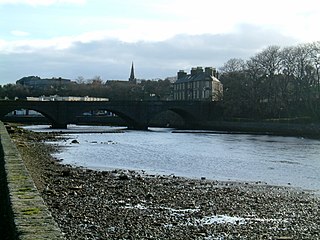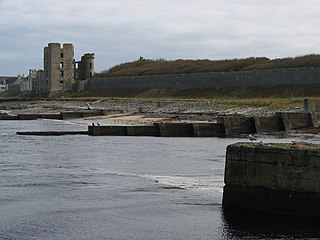
Sutherland is a historic county, registration county and lieutenancy area in the Highlands of Scotland. Its county town is Dornoch. Sutherland borders Caithness and Moray Firth to the east, Ross-shire and Cromartyshire to the south and the Atlantic to the north and west. Like its southern neighbour Ross-shire, Sutherland has some of the most dramatic scenery in the whole of Europe, especially on its western fringe where the mountains meet the sea. These include high sea cliffs, and very old mountains composed of Precambrian and Cambrian rocks.

Caithness is a historic county, registration county and lieutenancy area of Scotland.

Wick is a town and royal burgh in Caithness, in the far north of Scotland. The town straddles the River Wick and extends along both sides of Wick Bay. "Wick Locality" had a population of 6,954 at the time of the 2011 census, a decrease of 3.8% from 2001.

Diocese of Aberdeen was one of the 13 dioceses of the Scottish church, before the abolition of the episcopacy in 1689.

Dornoch Cathedral is a former cathedral and is now a Church of Scotland parish church serving the small Sutherland town of Dornoch, in the Scottish Highlands. As a congregation of the Church of Scotland, which is Presbyterian, the church is not the seat of a bishop but retains the name due to being, historically, the seat of the Bishop of Caithness. The Cathedral's churchyard is adjoined by Dornoch Castle, the somewhat reconstructed remains of the medieval palace of the Bishops of Caithness.

Thurso East is a coastline section of the Atlantic 0.5 miles (0.80 km) east of Thurso, Caithness, northern Scotland. It is situated at the mouth of the River Thurso, overlooked by the remains of Thurso Castle. The reef is made of layers of Caithness flagstone. It is Scotland's prime surfing venue on the north coast.

The Bishop of Caithness was the ecclesiastical head of the Diocese of Caithness, one of Scotland's 13 medieval bishoprics. The first referenced bishop of Caithness was Aindréas, a Gael who appears in sources between 1146 and 1151 as bishop. Aindréas spent much if not all of his career outside his see.
Pulteneytown Parish Church is located in Argyle Square, Pulteneytown, Wick, Caithness, Scotland. It is a congregation in the Church of Scotland.

Tingwall, is a parish in Shetland, Scotland. Located mostly on the Shetland Mainland, the centre lies about 2 miles north of Scalloway. Tingwall Airport is located in the village.

Thrumster is a crofting township on the main A99 road between Wick and Inverness. It is the nearest village to Wick. The transmission mast used to broadcast BBC television and radio signals to Caithness was located here until 1960.

Quarff is a small village on Mainland in the Shetland Islands in Scotland. It is located on the main A970 road, 5 miles (8.0 km) south of Shetland's only town, Lerwick. The village is spread along a classic glacial valley that runs east–west across the island between high hills to north and south, with centres of population at Easter Quarff which is near the main road and the east coast, and Wester Quarff which is 1½ miles west and faces the Atlantic Ocean. A narrow road runs along the valley between the two.

Glenorchy Parish Church is a congregation of the Church of Scotland in the village of Dalmally, Argyll and Bute, Scotland. It is the parish church of the parish of Glenorchy and Inishail. The church is also known as Glenorchy Kirk, and was historically known as the Church of Dysart. There have been many alternate spellings, including "Dysert", "Disart", "Glenwrquha", "Glenvrquha", "Glenvrquhay", "Clachandysert", "Clachan Disert, "Claghan-Diseirt" and "Dysart and Glenurquhie".

Whalsay Parish Church or Whalsay Kirk is a Church of Scotland parish church on the island of Whalsay, Shetland Islands, Scotland. It lies to the north of the village of Brough, on the southern part of a promontory known as Kirk Ness, connected to the mainland by a neck of land. It is the main burial ground for villagers of Whalsay. It is one of three churches in the Parish of Nesting, the others being at Nesting and Lunnesting. The church is a category B Listed Building.

Thurso Castle is a ruined 19th-century castle, located in Thurso, Caithness, in the Scottish Highlands. Situated in Thurso East, off Castletown Road, east of the River Thurso, the site can be seen from across the river. The current castle ruins date to 1872; A large part was demolished in 1952, although there has been a fortress here since the 12th century. Part of the castle is still habitable and remains a home of the Viscounts Thurso.

Old St Peter's Church is a ruined parish church on Wilson Lane, in Thurso, Caithness, Scotland. Dedicated to Saint Peter, it dates to at least 1125, and at one time was the principal church for the county, administered by the Bishops of Caithness. It became a scheduled monument in 1929 and from 1975 until 2016 it was also a Category A listed building.
Telford Parliamentary church also known as the Telford Kirks are a series of presbyterian churches in Scotland built with money voted from the parliament of the United Kingdom as a result of the Church of Scotland Act 1824 for a grant of £50,000, designed by the surveyor William Thomson and built by the Scottish stonemason and architect Thomas Telford. In total, 32 churches were built and many are still in use today. Others have been abandoned, e.g. at Stoer, while others were destroyed and rebuilt, e.g. at Tobermory, while others have been converted to dwellings.

David Carment (1772–1856) was a minister of first the Church of Scotland and then the Free Church of Scotland, who was involved in the Disruption of 1843 and in the legal troubles of the aftermath regarding church property ownership.















